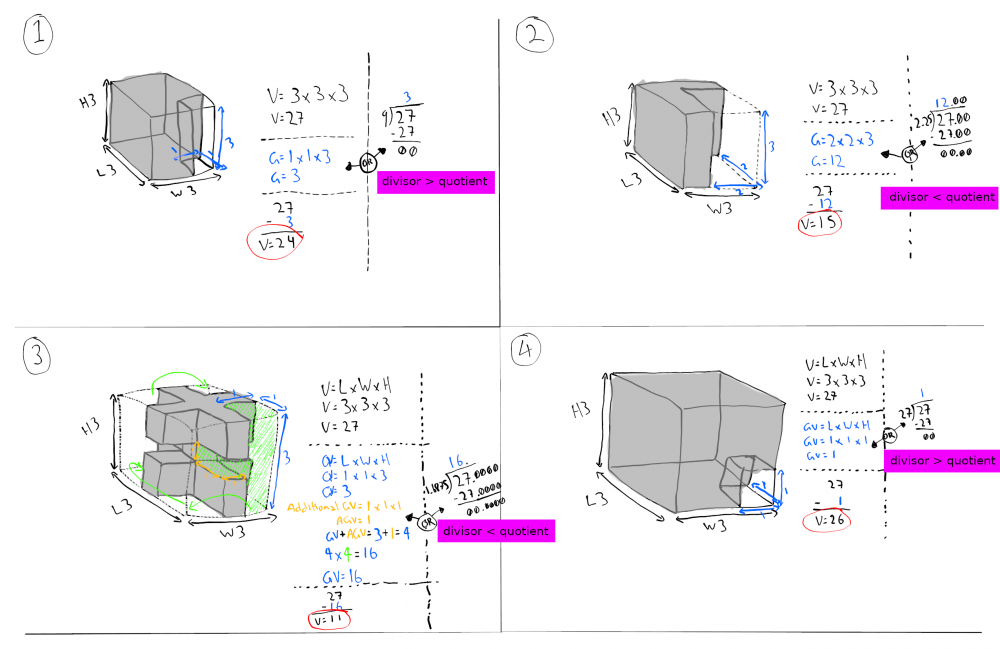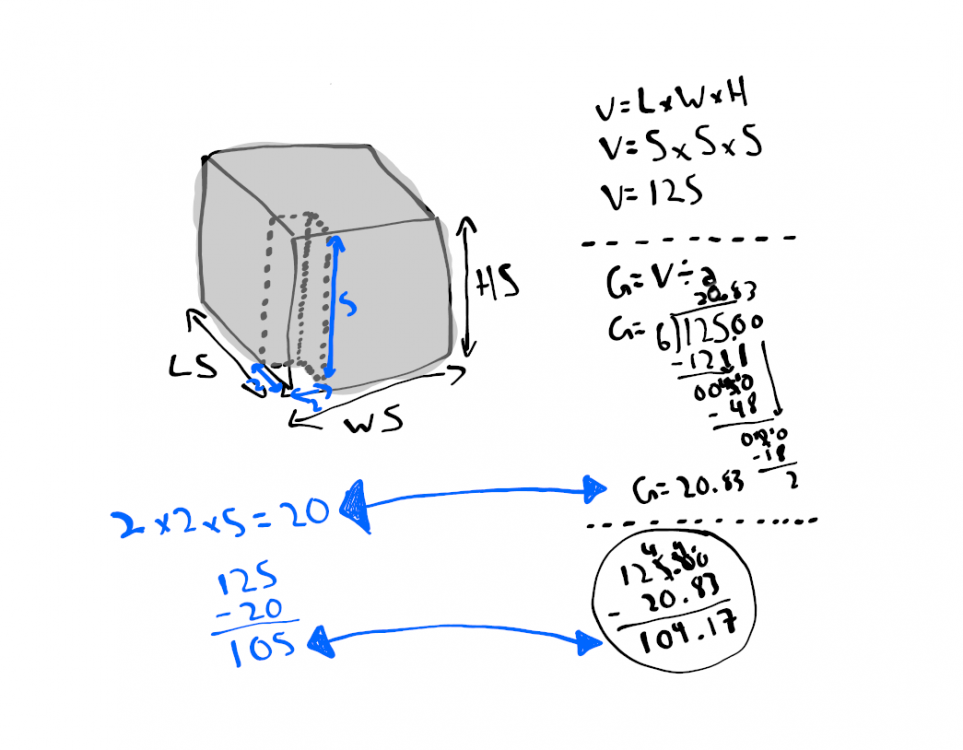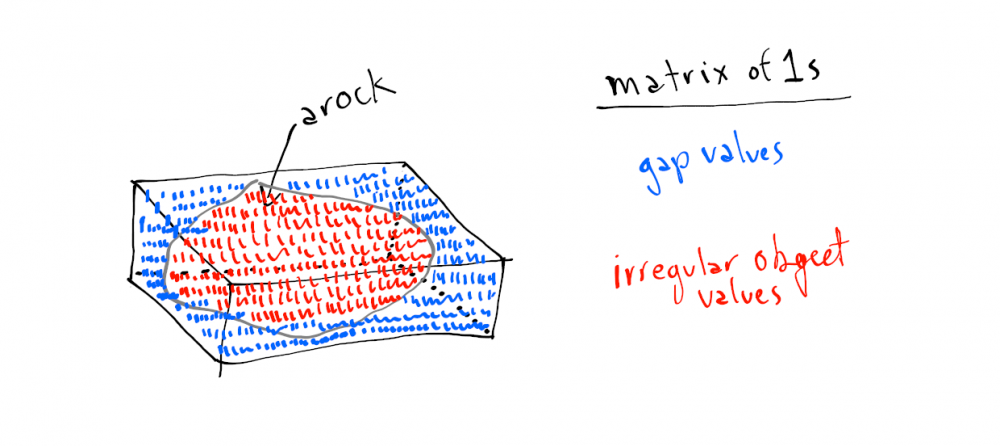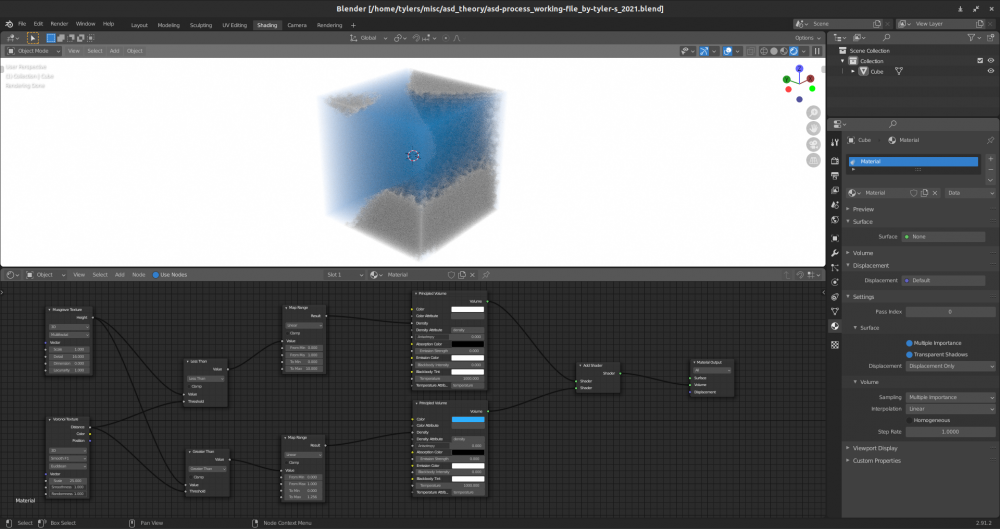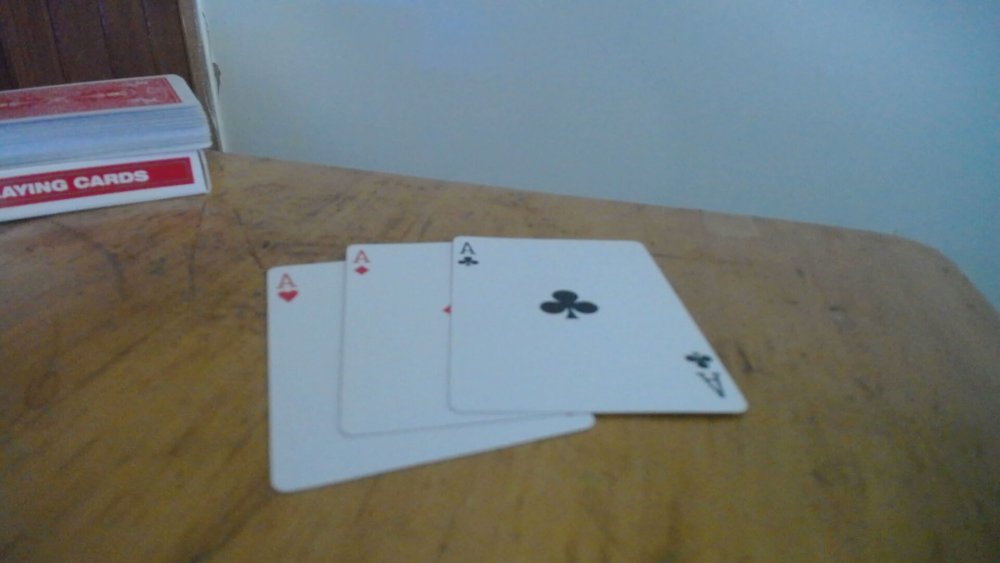-
Posts
150 -
Joined
-
Last visited
Content Type
Profiles
Forums
Events
Everything posted by tylers100
-
I think that the energy dispersal seems to be best answer. It reminds me of decay / decomposition, one of seemingly naturally-occurred states of living things that undergo after death. I wasn't sure because entropy and these first words / meanings (disorder, randomness, uncertainty) as impressed upon me is that scientists still don't understand it so that cause me to be not sure as well at first place.
-
Some words associated with the entropy definition as looked up: disorder randomness uncertainty energy dispersal I know that the consequence of entropy is irreversible, but which one of these associated words fit the entropy definition best?
-
This means I think that the Sun could possibly has a type of black hole inside (the core) but not the black hole we ordinarily know of. The black hole takes in light and stuff (to in) while the opposite version of black hole gives light (to out). In (Black Hole) and Out (Opposite version of black hole).
-
Questions and Answer Q - "Would you for instance declare that the process of melting is not a natural one ?" Q - "OK so what about processes caried out by (some) living things ?" Q - "Would you say flying is a natural process ?" A - These questions depend on a situation that constitutes what natural and non-natural is within human's scope of knowledge on that. That means a requirement is needed to understand what knowing what ultimately naturalness is. I think that we compare what is natural and non-natural based on our own judgments when the Nature is naturally occurred chaos but not in the disordered or randomized way that some people seem to think. I think the chaos concept need to be refined or approach differently. Because I sometime think some aspects of human's scope of understanding regarding the Nature is an inverse understanding. An inverse understanding = order way, seems how I see that way. Natural Process An example: A butterfly flipping it wings; form (starts) > growth > stable > decay > death (ends) then repeats. I'm referring natural process to be inclusive of both concept and physical, as applicable to any situation. But.. this natural causality hypothesis (especially with the model diagram) is "outside" of the Nature and describing what is occurring in either concept or physical is within the Nature. Yet, it has no observable evidence (especially of actual live interactions) as I already and recently stated.
-
Specific Observance I see the natural process in snow, trees, etc and I was gonna take a picture of that, but the model diagram or this natural causality hypothesis requires causality at work (being observed as live interactions) and I'm unable to capture that thus this hypothesis is useless without it. Lock or Move to Trash Can From now to future, I will refrain from proposing a hypothesis or theory unless I can capture live interactions. The interactions seemingly "are" there (presumably from microscopic level to macroscopic level or vice versa) as I seem to know that, but I have no technological means to capture or measure that or unless my mind is wrong. Lessons Learnt No hypothesis proposal unless have an observable evidence. No theory proposal unless have an observable evidence, model, and math.
-
Swansont, since I stated this natural causality to be hypothesis as per definition: Hypothesis Definition as I Understood it The hypothesis is an idea that assumes something that could be true but requires a research, expanding, disprove, or prove - that involves promoting and entailing a discussion. Theory Requires Evidence, Model, and Math The theory on other hand, you are right as I am more aware by now, requires a scientific model of various scientific types, math, and evidence. Yet this natural causality is not a presently theory since I already stated that I changed it to hypothesis because it obviously lacks research, expansion, discussion, scientific model or math etc hence this thread. Conceptual Model The model diagram I attached to my 1st post is a conceptual model, to clarify and depict the natural causality hypothesis. What is New? What is new regarding natural causality hypothesis? Is it could assess how the nature operates and handles the entropy issue in order to understand and how to co-exist with it better. Isn't that what the primary objective of science is (that is if I assumed correctly)? Here is some specific examples of observance: Some trees growing and some decaying to death (at areas nearby my home) Food decaying (ball of lettuce in my case, I frequently forget all about it) leaves on trees regrow in spring time and decay to death in the fall season onward through winter season. The patterns behind these seem to be as follow in an ordered way: form, growth, stable, decay, and death. The natural causality is my way of describing how the Nature operate with these patterns. Of course, that is a hypothesis and have to yield a further discussion and find out an evidence for that.
-

I am trying to learn some basic mathematics (Pre-algebra ) and Algebra
tylers100 replied to bayukutten's topic in Mathematics
Just letting you know that you're not alone with that. I'm one of those who performed poorly with math way back in high school and still need to re-learn some basics of mathematics onward to advanced ones if I'm well motive to do so. No Math, Yes Smash "Me no math, me smash!" Green Hulk talk, lol. Just kidding. Normally I don't comment because I don't really know or have a firm grasp of math, as my math knowledge has declined to low since my high school. But I have other comments based on my other strength areas if you don't mind. Conceptualization An ability to conceptualize math in your head and writing down math might will help you. Don't be afraid to make mistakes if practising. If you happen to make mistakes, self-assess your own cognition to find out why. Make sure to have a calculator with you (app on computer or IRL device) - it might could help you with that - to make an inference of your cognitive methods to understand and actualize math answers. Of course, I have to take this to my own mouth. Still, I feel compelled to comment anyway. I think the important thing to understand math is: understand why math (any field) is for find out how (i.e. step-by-step or similar to algorithms) to do a math Website I checked the www.math-only-math.com , it seems decent. I once tried to find some good websites that can get me from basic mathematics (arithematics) to advanced ones (idk termed fields), but I didn't get furthered with that - at this moment for now. Good with Math I hope you will become good at math, because it enables you to develop and be better at self-governance with billings, taxes, etc and / or specialize in fields or something like that. -
Communication Ok, just to make communication between us to be a bit more understandable and better, just letting you know that I am deaf. I use the English language differently as told by my dad; "deaf" writing. Model swansont, I was a bit confused about the model. I thought the diagram I produced that is attached to my 1st post is a model. But now, it seems to be insufficient from your perspective. I will attempt to produce another model according to guidelines I looked up on this website: link: https://www.carolina.com/teacher-resources/Interactive/how-to-make-a-good-scientific-model/tr39525.tr Just to check, is the scientific model guidelines on the stated website good enough? As for prediction.. Entropy Prediction link: https://en.wikipedia.org/wiki/Entropy As for potential prediction(s) yielded from this hypothesis, it is about entropy in context of the Nature based on my current understanding: 1st concept of entropy - irreversible: true 2nd concept of entropy - disorder, randomized, etc: false The Nature could be open system sustainability whereas humans manufacturing systems to be closed systems (in that case, 2nd concept is seemingly true) then proceed to impose 2nd concept on the Nature which could be per-matured assumptions and / or predictions about the entropy, specifically its 2nd concept, in the Nature. How? The Nature as Jigsaw Puzzles I think of the Nature as a completed picture of jigsaw puzzles. We, as humans, take something from the Nature then manufacture tools, foods, trashes, recycles, etc etc - that is akin to taking some puzzles from the completed picture then re-arrange these into a particular order (e.g. tools, foods, etc) then entropy, its 2nd concept, exists. But in case of the Nature apart from our tools, foods, etc - the 2nd concept of entropy seems not to exist - only so in ours because I think that we.. .. mismatch jigsaw puzzles in varying degrees. Get it? Quoting a snippet from the entropy wiki: "It has found far-ranging applications in chemistry and physics, in biological systems and their relation to life, in cosmology, economics, sociology, weather science, climate change, and information systems including the transmission of information in telecommunication." repeated link: https://en.wikipedia.org/wiki/Entropy ^ translates to found mismatched puzzles aka entropy. That is my current understanding regarding entropy.
-
Very well. Natural Process and Its Patterns Let's focus on the natural process for a moment, and consider its patterns; form, growth, stable, decay, and death. These are found in the Nature as obviously so (e.g. trees, grass, flowers, etc) and it is common sense that these are part of life span. It would be very silly for me to deny all of these as evidence, because these are apparently real in life.
-
Introduction A model diagram made by myself, is attached to this post. I recommend use it as reference while reading this post. Summary The idea is that all natural things follow the natural causality. From simplest to complexity (or vice versa) of life could be based on it, in an universal manner. History - Where Did Hypothesis Came From? The idea was inspired by the patterns in the Nature; form, growth, stable, decay, and death – as observed by myself. Originally, it was a theory by myself called, “General Causality Theory”. It was precursor-ed by adaptive semi-determinism or asd / ASD. It was first conceived by myself years ago but discarded after a while. After stopping with the asd thing, I decided to give this another try, which that resulted in an improvement with refining it. Then changed it into a hypothesis from theory because it is not fully developed, researched, and / or no math yet. Goal The goal of this is to see if natural causality hypothesis is true in an universal manner. And if true, then it could assist with providing some explanations for the common patterns in life, which from simplest to complexity (or vice versa) of life could be based on it. Natural Causality Concept The Natural Causality tells us what happens with the Nature. The parts that make up the natural causality concept: - Natural Process; form, growth, stable, decay, and death. - Causality; source, use, and make. - Interactions between both; Natural Process and Causality. Examples: Natural Process; form (tree seed), growth (tree growing), stable (tree at peak age), decay (old tree), and death (tree stops growing leaves and / or fall down). Causality; source (tree on soil ground / co2 / sunlight / etc), use (tree uses soil ground and co2, sunlight / etc), and make (clean air). Interactions between both; Natural Process and Causality (tree and everything surrounded it). Natural Process The natural process in an ordered way is; form, growth, stable, decay, and death. These are observed in everyday life as patterns. Causality I have divided the causality into three fundamental meanings. These are; source, use (cause), and make (effect). - Source is an energy or reason. It can be from any part of natural process. - Use is as cause by source in order to actualize making. An use can occur on any part of natural process. - Make is result by use. A making can actualizes any of natural process. [note: when if use and / or make occurs on any of natural process, that can be perceived as 'change' itself.] Interactions There are bi-directional interactions between natural process and causality – as shown on the model diagram. These show how causality can consider any of natural process as source, or an use can occur on any of natural process, and / or make any of natural process. These interactions could be reason why sometime the life seems to be overwhelming and complex – because some natural objects can be occupied in all interactions. Potential Usefulness This or model diagram could provide an improvement with understanding about interactions in the Nature, if found to be true.
-
Clarification I already am aware that I am no medical expert and generally should not participate in an applied medical health or other sections since I am not knowledgeable. But if my contribution might help a bit (e.g. 0.1%) chance despite my lack of knowledge on medical health matters, then maybe it might be worthy to see. I have to expand this with more clarifications and attempt to re-orient this toward scientific way. Goal To see if the Wall Theory might be a part of answer to deafness, paralyzed, blindness, or any of disability in humans - to see if regeneration is possible; restore disabilities back to working in an natural way. Abstract Obstacles What I talked about the Wall Theory is a bit abstract-based. I think of some objects as abstract obstacles affixed with meanings, but no termed or formal words (e.g. medical health termed words assigned to organs, cells, etc). Analogy in Context of Wall Theory A list of some objects to be used in an analogy: - A water pipe with a hatch. (surrounding nerve system) - Water. (nerve system) - Grassy ground. (general cells, responsible for receiving sensory information and actualize actions) An analogy: Water flowing (nerve system) in a pipe, fully so. A hatch (middle interface between) on the pipe is open, with water spewing out. The water spewing out into grassy ground, feeding or fuelling grass (cells). It is all working fine until something went wrong with the grass as caused by an outside influence. The hatch "automatically" closes to protect the water flowing - creating a wall obstacle. If outside condition is safe again, the hatch might re-open and re-connect with the grassy ground. But: In case of deafness, paralyzed, blindness, or some more disabilities I didn't think of in humans; the hatch closure (an obstacle wall) seems to be permanent. Other Thoughts That is all for now.
-
I'm not sure which forum section this belongs to, but here goes: I'm not expert, but still I have a theory called wall - not sure if this will help or not: Upon destruction or death (e.g. by infection, injury, etc) in certain cells responsible for interfacing between nerve system and cells responsible for receiving sensory information and actualize actions, human body makes a wall up thus promotion of growth or regeneration is disabled then ultimately a re-connection by nerve system is disabled. Why wall up? Maybe because of useless cells and / or to protect nerve system at first place or something like that. It is for deafness, paralyzed, and / or blind or any potential disability in humans.
-
No Method? Seems there is no way to obtain an accurate divisor or quotient (two missing variables) in a case of no measurement information on gap value number(s). Though, the division is there to be used.. but that would be unreliable and unpredictable (e.g. guessing) especially without two variables and gap value number(s). Or optionally can develop a spreadsheet with all possible numbers in division and decimals pertaining to the volume, then can try look up some approximately close to correct answer to identify divisor and quotient.. but still. Interesting Things to Note - The 1-4 examples picture I posted, the final ratio when added up together per (ex1 - 24:3, ex2 - 15:12, ex3 - 11:16, and 26:1) is always pattern of nine or 9, I'm a bit not sure what it is referring to.. the 9 blocks of 27, or something else? - If pattern of 9 x 3, we get 27 which is total volume of shown examples. This seems to show that the process is correct. Wrapping It Up I know when to stop, as I have been at this volume rabbit hole for around 1 week now. I guess I wanted an easy way to measure and obtain accurate volume number without having to use other ways of measuring and calculating - for any object.
-
Work in Progress I have written down imaginary measurements and calculations based on my depicted semi-irregular objects; there are four examples of that. All of it is on attached picture to this post. It is a part of my work in progress regarding finding or identifying a pattern in divisor, quotient, and a possible relation between both - for to better a method to obtain a gap value, number, or information from a limited volume information. Pattern in Divisor, Quotient, and Relation Between Both The pattern seems to show up is: more gap values means divisor is less than quotient while less gap values means divisor is greater than quotient. A possible ratio or proportion could be involved in that, but I'm not sure. Also, seems a clue or guessing process with divisor could be that finding out a divisor number that will get dividend down to zero the most direct way but I'm not sure about that as well. Example 1 to 4 Each depicting a simple volume measurement of semi-irregular object with various volume take-up (gray coloured) coupled with gap values already contained (blue coloured). And calculations (mostly black coloured) as well. Each example also has a comparison indicator (pink coloured - less or greater) for divisor and quotient. The Point If in any situation or event, a measurement of gap values is not doable, then what a reliable method to measure and calculate a volume of both everyday semi-irregular and irregular objects? That is what I'm trying to find out. Because presently measurement and calculation performed by myself for semi-irregular and irregular objects without gap measurement information, seems to be doable by division but with unpredictable result (e.g. guessing which precisely divisor and quotient it is). Seems additional visual information and / or other measurement methods will have to do for now.
-
Division Method to Obtain Amount of Gap Value Information Seems the division method is there to use. But it involves guessing which precisely and potential divisor or quotient number it is. Or a calculator is there to use to speed up the guess process or alternatively can develop a table with division of numbers ranging from 1.00 to how many maximum number specified on left (potential divisor or quotient) and upper (potential quotient or divisor), also with dividends (total volume) in contents (middle). However, this would involve an insanely large workload with Calc or Excel.. but the result would speed up the searching process for finding and identifying the divisor on order to obtain a gap value (quotient) then subtract volume with it to get a final volume amount for any irregular object. Divisor and Quotient Issue The issue with current process (including the division method and guessing) as per shown picture and previously updated post is that even if divisor is found (e.g. 6.25), and the quotient answer is 20 gap values or conversely (eg. 6.25 is the quotient and 20 is the divisor).. how to know which one is the correct divisor and quotient according to any situation? In a situation with the shown picture, it already supplied with additional information (e.g. predefined measurements - blue coloured). Seems more information is required to supply in order to complete the volume math measurement and calculation. Reason for Gap Values This could be a possible practical and efficient measurement & calculation process. Also, to obtain an accurate volume number of any irregular object based on an finite amount of information (eg. just LxWxH). When an irregular object is measured with the simple volume measurement, it would already contain gap information. If a better solution is found regarding the amount of gap information and division method, it could be useful somehow.
-
Updated: The more correct divisor for the shown and attached picture is actually 6.25 , however I still am not sure or certain as how to obtain that divisor number. The guessing process with divisor is not exactly helpful. Another interesting thing to note; the quotient answer as per repeated pattern from some examples I produced seems to be always in number greater than divisor.. this maybe could be a clue to finding out how to obtain a correct divisor at first place.
-
I think I might found a solution for the tricky part, the amount of gap values. Solution Step 1: Total Volume, V = L x W x H. Step 2: Division, Gap (quotient) = dividend (volume) / divisor (guess). Divide the volume with an educational guessed number of divisor that will get the dividend down to zero the most direct or shortcut way. The quotient answer is the amount number of gap value. Step 3: Subtraction, V - Gap. Subtract the volume with the amount number of gap value to obtain an approximately close or even accurate number of volume number or information for an irregular object being measured and calculated. How did I know I was writing down math stuff then used imaginative answer that yielded from measuring imaginative semi-irregular objects (for easier measurement and calculation) then compared it against the division solution with calculator, either answer seems to approximately close to right however except for decimal and maybe rounding issues in some cases. Uncertainty I am a bit uncertain if this is a correct solution or not. Because of decimal and rounding maybe based on comparisons between my perform math and used calculator. (See attached picture to show what I'm talking about.)
-
Water Displacement Method This web-page says to use water displacement method to do so: https://sciencing.com/do-volume-object-6199021.html Another Way? But, is there a way to measure an irregular object without having to use the water displacement method for practical use with everyday objects? Gap Value The interesting thing about the formula for square or rectangled volume is that if used to measure irregular shaped objects, it would already contain gap information or gap values. The next step would be to find out how many amount gap number is then use total volume to subtract it to obtain an accurate volume for irregular object being measured. But the thing is I don't know how to obtain the amount of gap value number. Why Gap Value? Since the math is used as tool so the value number for every space occupied is 1 from my perspective. The reason for this is because I see an irregular object, when measured with volume formula LxWxH, as being a local matrix of 1s occupying every dimensional space as being uniform. The gap would be the space occupied in the measured volume. Picture attached to show what I'm talking about.
-
Hello all. I haven't formally introduced myself yet until now. Existing Member I came here several years ago, with a mild interest in science. I was searching for something. Then life happened. Education Background I'm a non-scientist and non-mathematician. But I still hold some interests in physics, philosophy, and maybe more fields. My formal education was art. Scientific Experiments and Tools My laboratory and experiments exist only in my head. I try to maximize my imagination or visualization to better approximate my ideas or comprehension of other own ideas. However, I'm now aware these are unreliable. Forum Activity My time is freed up a bit, so I might be more active from time to time and able to learn a thing or two and maybe contribute something useful.
-
No math or model. I stopped with the ASD theory thing. Thank you and others for patience with this thread.
-
Properties Maybe yes. It could be density and lacunarity property, and maybe more. A proportional ratio relation between both or more. An attached of cropped screenshot picture to this post is my own produced example of using density, lacunarity, and other properties involved in the process to define a volume in an object (cube) via using the Blender software. It is possible that the properties and other mathematical operators involved in the shown process, could be modified to use volume / density / lacunarity to define not just volume in an object, but also its surface / geometry - for a possible improvement and accuracy with modelling, sculpting, simulation, mapping, etc.
-
It still a part of my point with previously posted pictures, it merely cementizes my point. I will re-state the point:
-
-
Ok, let's try forget the termed words, ASD (original) or Life Directionality (revised), for a moment and consider a process that which I am trying to tell about. I have put this post together based on a paper I produced with my own produced examples (my pictures, attached to this post) to define and explain the process. Here goes: Title: Process Theory Subject: Nature, Science, Philosophy Type of Post Content: Theory Summary: How an idea (i.e. abstract) and / or physical matter (i.e. concrete) could be formed, stabilized, or disintegrated by an universal process - an equalization toward an equilibrium and its yielding result. [Note: For a general and simple use of object or more for rest of this, a thing or object is to be labelled as ‘x’, ‘y’, or ‘more’. These x, y, or more refer to generally anything.] Awareness The awareness is as follow: Aware of an event or situation; an observation or detection. Definition: To be aware of an event or situation is to firstly sense something, that may be already known or unknown. Example: Something is being sensed by myself. (See picture 1 of 6) Objectivity The objectivity is as follow: x is x, or x = x Definition: (x) A thing and its belonging possession of part excluding other or another (i.e. same to it), is henceforth recognized (assigned) as an independent thing, an entity, or object. Example: Something is recognized to be a deck of cards by myself. (See picture 2 of 6) Connectivity The connectivity is as follow: x and y or more Definition: A connection between an (x) object and another or other (y) object or more. It may include a correlation, link, relation, or relationship between both or more. Example: All cards shown to be grouped together by myself. (See picture 3 of 6) Condition or Comparison The condition or comparison is as follow: x [*] y or more [*]: equal, greater than, less than, equal or greater, equal or less, not equal Definition: A condition or comparison between an (x) object and another or other (y) object or more according to a value, number, statistics, properties, and / or appearance shape or form (e.g. dimensional sizes). Example: A condition or comparison between three cards by myself. (See picture 4 of 6) Operational Transformation The operational transformation is as follow: x, y, or more [equalize*] between each other to an equilibrium, yielding a result, standard, product, or by-product. This can be seen as a positive outcome, neutral outcome, or negative consequence. [*]: addition, subtraction, multiplication, division, modulus, increment, decrement, creation, construction, modelling, sculpting, typing, writing, texting Definition: An action or interaction between an (x) object and another or other (y) object or more – yielding a result, standard, product, or by-product - as standardization of sort. Example: Three cards constructed (three cards equalize between each other to an equilibrium) as a tent (yielded a result, standard, product, or by-product) by myself. (See picture 5 of 6) Point This defines and explains how an idea (i.e. abstract) or physical matter (i.e. concrete) could be interpreted to be created, formed, emerged, or disintegrated by an equalization toward an equilibrium and its yielding result. The relation and sustainability both may play an important role in that. Example: The tent of cards is disintegrated by myself. (See picture 6 of 6) My Questions a. Is there already a term word for this process? b. If no, what should I call this process? c. Does the process work in the Nature or a natural situation?



